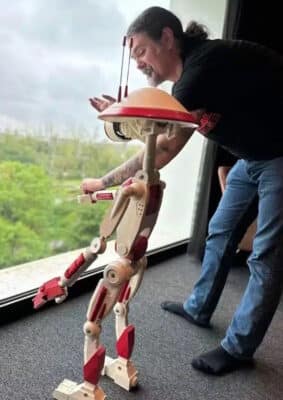Ella — a smart stroller from Glüxkind Technologies, a startup in Vancouver, Canada — kicked off the year when it was named an honoree in the CES 2023 Innovation Awards.
The canny carriage uses computer vision running on the NVIDIA Jetson edge AI platform to follow parents. Its AI-powered abilities, like smart braking and a rock-my-baby mode, captured the attention of media outlets like Good Morning America and The Times of London as well as an NVIDIA AI Podcast interview with its husband-and-wife cofounders.
A member of NVIDIA Inception, a free program for cutting-edge startups, Glüxkind was one of seven companies with NVIDIA-powered products recognized at the Las Vegas event in January. They included:
- John Deere for its fully autonomous tractor
- AGRIST for its robot that automatically harvests bell peppers
- Inception member Skydio for its drone that can fly at a set distance and height without manual intervention
- Neubility, another Inception member, for its self-driving delivery robot
- Seoul Robotics, a partner in the NVIDIA Metropolis vision AI software, for its Level 5 Control Tower that can turn standard vehicles into self-driving care
- WHILL for its one-person vehicle that automatically guides a user inside places like airports or hospitals
mGripAI dexterously packs food
Bedford, Mass.-based Inception member Soft Robotics introduced its mGripAI system to an $8 trillion food industry hungry for automation. It combines 3D vision and AI to grasp delicate items such as chicken wings, attracting investors that include Tyson Foods and Johnsonville.
Soft Robotics uses the NVIDIA Omniverse platform and NVIDIA Isaac Sim robotics simulator to create 3D renderings of chicken parts on conveyor belts or in bins. With help from AI and the ray-tracing capabilities of NVIDIA RTX technology, the robot gripper can handle as many as 100 picks per minute, even under glare or changing light conditions.
“We’re all in on Omniverse and Isaac Sim, and that’s been working great for us,” David Weatherwax, senior director of software engineering at Soft Robotics, said in a January interview.
TM25S provides a keen eye in the factory
In a very different example of industrial digitalization, electronics manufacturer Quanta is inspecting the quality of its products using the TM25S, an AI-enabled robot from its subsidiary, Techman Robot.
Using Omniverse, Techman built a digital twin of the inspection robot — as well as the product to be inspected — in Isaac Sim. Programming the robot in simulation reduced time spent on the task by over 70%, compared with programming manually on the real robot.
Then, with optimization tools in Isaac Sim, Techman explored a massive number of program options in parallel on NVIDIA GPUs. The end result, shown in the video below, was an efficient solution that reduced the cycle time of each inspection by 20%.
Saildrone takes to the seas for data science
Saildrone, another Inception startup in Alameda, Calif., created uncrewed watercraft that can cost-effectively gather data for science, fisheries, weather forecasting and more.
NVIDIA Jetson modules process data streams from their sensors, some with help from NVIDIA Metropolis vision AI software such as NVIDIA DeepStream, a development kit for intelligent video analytics.
The video below shows how three of Saildrone’s smart sailboats are helping evaluate ocean health around the Hawaiian Islands.
Caltech M4 sets its sights on Mars
The next stop for one autonomous vehicle may be the red planet.
Caltech’s Multi-Modal Mobility Morphobot, or M4, can configure itself to walk, fly, or drive at speeds up to 40 mph (see video below). An M42 version is now in development at NASA as a Mars rover candidate and has attracted interest for other uses such as reconnaissance in fire zones.
Since releasing a paper on it in Nature Communications, the team has been inundated with proposals for the shape-shifting drone built on the NVIDIA Jetson platform.
Zipline delivery drones fly high
The year ended on a high note with Zipline announcing that its delivery drones flew more than 55 million miles and made more than 800,000 deliveries since the company’s start in 2011. The San Francisco-based company said it now completes one delivery every 70 seconds, globally.
That’s a major milestone for the Inception startup, the field it’s helping pioneer, and the customers who can receive everything from pizza to vitamins up to seven faster than by truck.
Zipline’s latest drone uses two Jetson Orin NX modules. It can carry 8 lb. of cargo for 10 miles at up to 70 mph to deliver packages in single-digit minutes while reducing carbon emissions 97% in comparison with gasoline-based delivery vehicles.
NVIDIA notes maker machines that inspire and amuse
Individual makers designed two autonomous vehicles this year worth special mentions.





